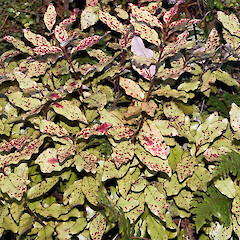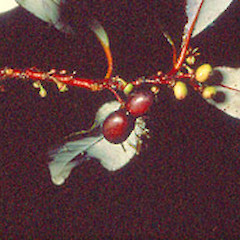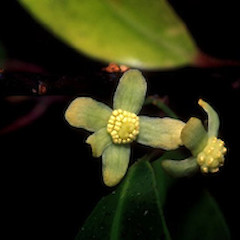Pseudowintera colorata
Common name
red horopito, mountain horopito
Synonyms
Drimys colorata Raoul, Drimys axillaris var. colorata (Raoul) Kirk, Wintera colorata Tiegh.
Family
Winteraceae
Flora category
Vascular – Native
Endemic taxon
Yes
Endemic genus
Yes
Endemic family
No
Structural class
Trees & Shrubs - Dicotyledons
NVS code
The National Vegetation Survey (NVS) Databank is a physical archive and electronic databank containing records of over 94,000 vegetation survey plots - including data from over 19,000 permanent plots. NVS maintains a standard set of species code abbreviations that correspond to standard scientific plant names from the Ngä Tipu o Aotearoa - New Zealand Plants database.
PSECOL
Chromosome number
2n = 86
Current conservation status
The conservation status of all known New Zealand vascular plant taxa at the rank of species and below were reassessed in 2017 using the New Zealand Threat Classification System (NZTCS) – more information about this can be found on the NZTCS website. This report includes a statistical summary and brief notes on changes since 2012 and replaces all previous NZTCS lists for vascular plants.
Please note, threat classifications are often suggested by authors when publications fall between NZTCS assessment periods – an interim threat classification status has not been assessed by the NZTCS panel.
- Conservation status of New Zealand indigenous vascular plants, 2017 . 2018. Peter J. de Lange, Jeremy R. Rolfe, John W. Barkla, Shannel P. Courtney, Paul D. Champion, Leon R. Perrie, Sarah M. Beadel, Kerry A. Ford, Ilse Breitwieser, Ines Schönberger, Rowan Hindmarsh-Walls, Peter B. Heenan and Kate Ladley. Department of Conservation. Source: NZTCS and licensed by DOC for reuse under the Creative Commons Attribution 4.0 International licence.
2017 | Not Threatened
Previous conservation statuses
2012 | Not Threatened
2009 | Not Threatened
2004 | Not Threatened
Brief description
Dark shrub with pepper-tasting leaves blotched red above and coloured white underneath
Distribution
Endemic. North, South and Stewart Islands
Habitat
Coastal, lowland, or montane forest margins and shrubland
Wetland plant indicator status rating
Information derived from the revised national wetland plant list prepared to assist councils in delineating and monitoring wetlands (Clarkson et al., 2021 Manaaki Whenua – Landcare Research Contract Report LC3975 for Hawke’s Bay Regional Council). The national plant list categorises plants by the extent to which they are found in wetlands and not ‘drylands’. The indicator status ratings are OBL (obligate wetland), FACW (facultative wetland), FAC (facultative), FACU (facultative upland), and UPL (obligate upland). If you have suggestions for the Wetland Indicator Status Rating, please contact: [Enable JavaScript to view protected content]
FACU: Facultative Upland
Occasionally is a hydrophyte but usually occurs in uplands (non-wetlands).
Detailed description
Shrub to 3.5 m tall; trunks and branches upright; bark dark; branchlets dark. Plants glabrous. Petiole slender, 5-10 mm long, dark reddish brown. Leaves alternate, pungent and pepper-tasting; midvein inconspicuous above, raised below; lamina 2-6(-8) x 1-3 cm, elliptic, margin undulate, tip obtuse to subacute, coriaceous, upper surface matt green to yellowish-green, blotched with red in exposed situations, undersides glaucous to white and often pink-flushed. Inflorescences axillary, flowers bisexual, c. 1 cm diam., in fascicles of 1-3, on slender pedicels 5-10 mm long, bracts ciliate. Calyx cupule margins subentire to shallowly lobed. Corolla comprised of 5-(6) free petals, these 4-5 mm long, linear to narrow-oblong, greenish yellow, apex obtuse. Carpels 1-5, us. 1-2 maturing, stigma apical. Stamens 5-20. Fruit a 2-3-seeded fleshy globose to subglobose berry, 5-6 mm diam., dark red or black, flesh red. Seed 1- or 3-angled, obovate to elliptic, 2.6-3.6 mm, surface irrregular.
Similar taxa
Most similar in appearance to P. axillaris which has shining green leaves that are not white underneath and the rare P. insperata of Northland which often has small hairs on the leaf underside and has 13-22 stamens. Neither of these 2 species have leaves that are particularly peppery to taste.
Flowering
November-March
Flower colours
Yellow
Fruiting
December-June
Threats
Not Threatened. Often one of the few shrub species in heavily browsed forests
Etymology
pseudowintera: False Wintera (a related genus)
colorata: Coloured
Attribution
Description adapted from Allan (1961, Heenan and de Lange (2006), Eagle (2000), Webb and Simpson (2001).
References and further reading
Allan, H.H. 1961. Flora of New Zealand. Government Printer, Wellington;
Heenan, P.B, de Lange, P.J. 2006. Pseudowintera insperata (Winteraceae), an overlooked and rare new species from northern New Zealand. NZ J. Botany 44: 89-98;
Eagle, A. 2000. Eagle’s complete trees and shrubs of NZ. Te Papa Press, Wellington;
Webb, C.J. & Simpson, M.J.A. 2001. Seeds of NZ gymnosperms and dicotyledons. Manuka Press, Christchurch.
NZPCN Fact Sheet citation
Please cite as: de Lange, P.J. (Year at time of access): Pseudowintera colorata Fact Sheet (content continuously updated). New Zealand Plant Conservation Network. https://www.nzpcn.org.nz/flora/species/pseudowintera-colorata/ (Date website was queried)



















